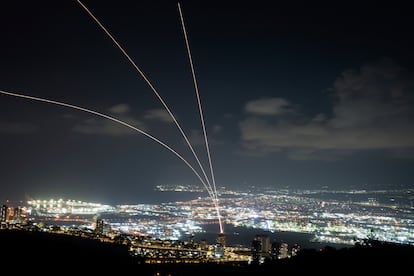Thousands of Israeli troops deployed on border for possible ground invasion of Lebanon
The IDF is replicating its Gaza strategy and forcing thousands of Lebanese families to flee amid intense bombardments against Hezbollah. Meanwhile, three ‘highly trained and motivated’ divisions transferred from the Strip await the order to invade

Israel has stepped up its military efforts on the northern front in recent hours amid a spiral of unprecedented violence that left 492 people dead in Lebanon on Monday. In what apparently represents the leap to a new stage of warfare, the government and the army have shown their determination to destroy Hezbollah’s infrastructure and to encircle its leader, Hassan Nasrallah, who is increasingly isolated while his lieutenants are being assassinated. At the same time, Israel has deployed thousands of military personnel on standby for a possible ground invasion of the neighboring country. The latest Israeli moves reveal that the army has decided to adopt the same strategy developed in Gaza since the beginning of the war against Hamas on October 7, 2023. Telephone warnings, leaflet drops, media and social networks are being used to urge Lebanese citizens to leave their places of residence, something that thousands of families did on Monday in order not to be considered as targets. The Lebanese government has announced an emergency plan to accommodate them.
In the absence of a ceasefire agreement, which at this stage does not appear to be imminent, the Israel Defense Forces (IDF) are trying at all costs to push back the Hezbollah units that are deployed closest to Israeli territory. The objective, for which they have been reinforcing the northern front for weeks with troops arriving from Gaza, is twofold. On the one hand, to make it more difficult for Hezbollah to attack the northernmost communities in Israel. On the other, to prevent them from carrying out ground skirmishes or even a coordinated incursion similar to the one Hamas carried out last year from Gaza.
This is what Lieutenant Colonel Yarden (who prefers not to have his last name published) explained during an online conversation with several journalists on Sunday evening from his post on the border. At that time, Israeli fighter planes were preparing to launch the biggest air strike of the current conflict against targets in Lebanon. Israel is primarily flexing its military might from the air, but the officer stated that the IDF is in a position to launch a ground invasion immediately.
“We have several highly trained and highly motivated assault divisions that are ready, willing, and capable of carrying out that mission,” he said, although he acknowledged that the government that must give the final go-ahead. Prime Minister Benjamin Netanyahu can order the invasion at any time.
Monday’s airstrikes were the prelude to a new phase of the conflict, said the head of the Israeli Armed Forces, General Herzi Halevi, adding that he would soon provide more details. “We are striking targets and preparing for the next phases,” he said, referring to the bombings to try to destroy the infrastructure built up by Hezbollah over the last two decades, after the last major conflict with Israel in the summer of 2006. The prelude was a week of attacks causing dozens of deaths after the detonation of hundreds of Hezbollah personal communication systems (pagers and walkie-talkies), attributed to the Israeli secret services, and an attack from the air against a senior militia commander.
“In the past day, we are crushing what was built by Hezbollah for 20 years. Nasrallah remains alone at the helm, entire units of the Radwan Force [the militia’s special forces] were taken out of service, and tens of thousands of rockets were destroyed,” said Defense Minister Yoav Gallant.
Meanwhile, in the mountains along the border, the Israeli military is preparing for a possible order to assault Lebanon by land. “We have a lot of troops concentrated on the border, ready for the government to make a decision on whether we need to launch a large ground operation,” the lieutenant colonel told reporters. Over the past month, he said, a significant part of the troops deployed in Gaza have been transferred north.
“If during the height of the fighting in the Strip there were five divisions operating there, today there are only two divisions, in the south. Those other three divisions have not evaporated. They are training, resting, and preparing for any mission that the government asks the army to carry out in the northern theater,” he added without providing further details, but those three divisions consist no fewer than 15,000 troops.
The number of victims has skyrocketed in recent hours under Israeli air strikes. On Monday alone, the death toll rose to over 490, dozens of them women and children, with more than 1,600 people wounded in different regions of the country. It was the deadliest day in Lebanon since the end of the civil war in 1990.
Hezbollah, for its part, does not have an air force, but it has launched dozens of missiles in an attempt to show that it still has an arsenal capable of unsettling the enemy. For the first time in the current conflict, some of these projectiles hit the West Bank Monday at a range of over 60 miles, without being intercepted by Israeli air defenses. No fatalities were reported. Haifa Bay, around 19 miles from the border, was illuminated as night fell on Monday amid constant activity by the Israeli Iron Dome anti-aircraft system in response to the firing of projectiles by the Lebanese Shia militia.

As the bombing storm loomed, the Israeli army issued warnings to Lebanese civilians on Monday to stay away from Hezbollah militants, installations, and any other place that might be in the hands of the party-militia. Thousands of families formed long caravans to escape the bombs while the authorities in Beirut announced a national emergency plan to deal with the displaced.
In recent hours, Israel has released what it considers evidence that the militia is using civilian infrastructure to carry out attacks and is holding the population hostage. Netanyahu himself warned of this in a message he issued Monday evening, in which he stressed that the Lebanese people, despite Monday’s death toll, are not the target.
“There are about 100,000 Lebanese who have fled [the area around the border with Israel] because Hezbollah uses their villages, including mosques, hospitals, clinics or schools, as places to launch rockets and missiles against Israeli civilians,” said the lieutenant colonel, who is convinced that the militants are holding the country “hostage.” He is also convinced that “they were planning to invade northern Israel” with “their elite forces,” said the veteran reservist, who has been deployed since the beginning of the war in the sector closest to the Mediterranean coast of the Lebanese border, one of the places where tension has soared in recent days.
On the Israeli side, there are about 60,000 evacuees due to the conflict. “We are committed to bringing our citizens back to their homes. And that will happen when there is an agreement. That agreement can happen now or it could happen after a major ground operation,” explains Yarden, who warns: “We have seen the kind of destruction and damage that has taken place in the Gaza Strip; I hope the Lebanese people take that into account.” The military officer sums up the current situation as follows: “There is much less fighting in Gaza,” where what remains “for the most part is a kind of guerrilla war. There are a lot of forces in the north, with me, oriented towards Lebanon,” he concludes.
Sign up for our weekly newsletter to get more English-language news coverage from EL PAÍS USA Edition
Tu suscripción se está usando en otro dispositivo
¿Quieres añadir otro usuario a tu suscripción?
Si continúas leyendo en este dispositivo, no se podrá leer en el otro.
FlechaTu suscripción se está usando en otro dispositivo y solo puedes acceder a EL PAÍS desde un dispositivo a la vez.
Si quieres compartir tu cuenta, cambia tu suscripción a la modalidad Premium, así podrás añadir otro usuario. Cada uno accederá con su propia cuenta de email, lo que os permitirá personalizar vuestra experiencia en EL PAÍS.
¿Tienes una suscripción de empresa? Accede aquí para contratar más cuentas.
En el caso de no saber quién está usando tu cuenta, te recomendamos cambiar tu contraseña aquí.
Si decides continuar compartiendo tu cuenta, este mensaje se mostrará en tu dispositivo y en el de la otra persona que está usando tu cuenta de forma indefinida, afectando a tu experiencia de lectura. Puedes consultar aquí los términos y condiciones de la suscripción digital.
More information
Archived In
Últimas noticias
Tiger Woods turns 50: Will he continue playing on the PGA Tour or take a back seat?
The surreal journey of James Nnaji, the Barcelona youth player selected in the NBA Draft who ended up in the NCAA
Trump claims peace in Ukraine is near, but Moscow suggests otherwise
A survivor’s account of the Interoceanic Train accident: ‘We were scared because of the speed on the curve’
Most viewed
- Oona Chaplin: ‘I told James Cameron that I was living in a treehouse and starting a permaculture project with a friend’
- Reinhard Genzel, Nobel laureate in physics: ‘One-minute videos will never give you the truth’
- Sinaloa Cartel war is taking its toll on Los Chapitos
- Why the price of coffee has skyrocketed: from Brazilian plantations to specialty coffee houses
- Chevy Chase, the beloved comedian who was a monster off camera: ‘Not everyone hated him, just the people who’ve worked with him’









































